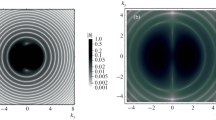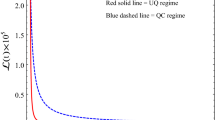Abstract
Nonstationary perturbation theory is used to study generation of quantum vortices resulting from ionization of hydrogen-like atom by an ultrashort pulse of classical electromagnetic field. It is shown that the vortices are determined by quantum interference effects.







Similar content being viewed by others
REFERENCES
W. J. Kwon, J. H. Kim, S. W. Seo, and Y. Shin, Phys. Rev. Lett. 117, 245301 (2016).
K. Sasaki, N. Suzuki, and H. Saito, Phys. Rev. Lett. 104, 150404 (2010).
G. W. Stagg, A. J. Allen, C. F. Barenghi, and N. G. Parker, J. Phys. Conf. Ser. 594, 012044 (2015).
L. G. Loitsyanskii, Fluid Mechanics: College Textbook, 7th ed. (Drofa, Moscow, 2003).
M. I. Rabinovich, Sov. Phys. Usp. 21, 443 (1978).
J. M. Ngoko Djiokap, S. X. Hu, L. B. Madsen, N. L. Manakov, A. V. Meremianin, and A. F. Starace, Phys. Rev. Lett. 115, 113004 (2015).
L. Ph. H. Schmidt, C. Goihl, D. Metz, H. Schmidt-Böcking, R. Dörner, S. Yu. Ovchinnikov, J. H. Macek, and D. R. Schultz, Phys. Rev. Lett. 112, 083201 (2014).
N. V. Larionov and M. I. Kolobov, Phys. Rev. A 88, 013843 (2013);
M. O. Scully and M. S. Zubairy, Quantum Optics (Cambridge Univ. Press, 1997).
I. V. Bargatin, B. A. Grishanin, and V. N. Zadkov, Phys.-Usp. 44, 597 (2001);
The Physics of Quantum Information: Quantum Cryptography, Quantum Teleportation, Quantum Computation, Ed. by D. Bouwmeester, A. K. Ekert, and A. Zeilinger (Springer, 2000).
A. A. Ishchenko, S. A. Aseev, V. N. Bagratashvili, V. Ya. Panchenko, and E. A. Ryabov, Phys.-Usp. 57, 633 (2014). doi 10.3367/UFNe.0184.201407a.0681
S. Yu. Ovchinnikov, N. V. Larionov, A. A. Smirnovskii, and A. A. Shmidt, Nauchno-Tekh. Vedomosti SPbGPU. Fiz.-Mat. Nauki 10 (4), 111 (2017).
J. M. Ngoko Djiokap, A. V. Meremianin, N. L. Manakov, S. X. Hu, L. B. Madsen, and A. F. Starace, Phys. Rev. A 94, 013408 (2016).
L. D. Landau and E. M. Lifshitz, Quantum Mechanics: Non-Relativistic Theory, 6th ed. (Fizmatlit, Moscow, 2004).
N. B. Delone and V. P. Krainov, Nonlinear Ionization of Atoms by Laser Radiation (Fizmatlit, Moscow, 2001).
D. G. W. Parfitt and M. E. Portnoi, J. Math. Phys. 43, 4681 (2002).
X. L. Yang, S. H. Guo, F. T. Chan, K. W. Wong, and W. Y. Ching, Phys. Rev. A 43, 1186 (1991).
E. Madelung, Die mathematischen Hilfsmittel des Physikers (Springer, Berlin, 1957).
N. N. Rosanov, Opt. Spectrosc. 124, 72 (2018).
Author information
Authors and Affiliations
Corresponding author
Additional information
Translated by A. Chikishev
APPENDIX
APPENDIX
Cylindrical waves represented in terms of momenta. We use the known expressions for the Bessel function [17]:
properties
and condition (13) to derive the following momentum representation of cylindrical waves:
For negative projections, quantity kx,y is chan-ged by quantity |kx,y|. The coefficients are Cm = 1 at kx,y > 0 and m ≥ 0 or kx,y < 0 and m ≤ 0 and Cm = (–1)m at kx, y > 0 and m < 0 or kx,y < 0 and m > 0.
Radial component of the matrix element of perturbation operator 〈α, |m'||ρ|β, |m|〉 (10) calculated in the free-electron approximation. For the transition of hydrogen atom from the ground state to the state of continuous spectrum, we have
When transitions to the final state of continuous spectrum via intermediate states of the same continuous spectrum are considered, we must calculate the following matrix elements 〈k, |m||ρ|k', |m\( \mp \) 1|〉. Such calculations can be performed using the known expressions that are satisfied for cylindrical functions [17]
and condition (13). Then, we obtain
and
Rights and permissions
About this article
Cite this article
Larionov, N.V., Ovchinnikov, S.Y., Smirnovsky, A.A. et al. Perturbation Theory in the Analysis of Quantum Vortices Formed by Impact of Ultrashort Electromagnetic Pulse on Atom. Tech. Phys. 63, 1569–1575 (2018). https://doi.org/10.1134/S1063784218110166
Received:
Published:
Issue Date:
DOI: https://doi.org/10.1134/S1063784218110166




